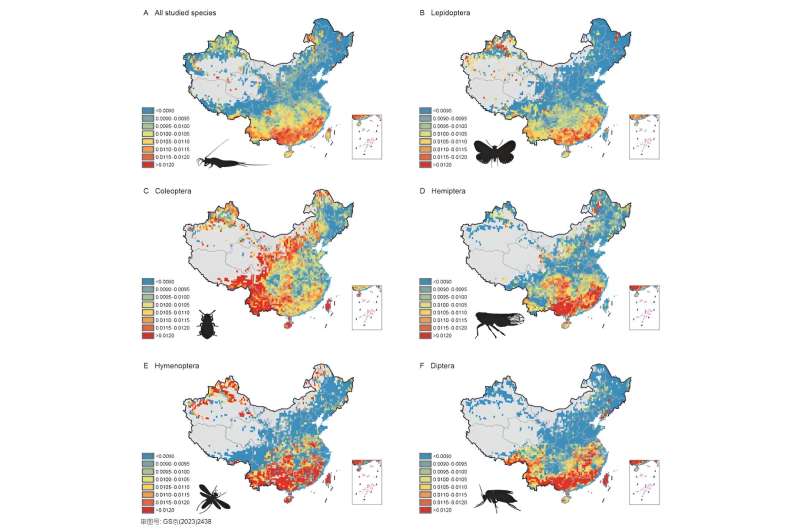This article has been reviewed according to Science X's editorial process and policies. Editors have highlighted the following attributes while ensuring the content's credibility:
fact-checked
peer-reviewed publication
trusted source
proofread
Study assesses geographical patterns and determinants of insect biodiversity in China

A new study titled "Geographical patterns and determinants of insect biodiversity in China" and published in Science China Life Sciences has been led by Prof. Fuwen Wei (Institute of Zoology, Chinese Academy of Sciences and Jiangxi Agricultural University) and Prof. Gexiao Qiao (Institute of Zoology, Chinese Academy of Sciences).
The researchers collected 467,958 high-quality insect species distribution records from the Global Biodiversity Information Facility (GBIF) and the China National Specimen Database of Animals. They used stacked Species Distribution Models (SSDMs) to predict the potential distribution ranges of 14,115 insect species distributed in China, assessing the national insect biodiversity patterns. The results revealed high insect species diversity in Southeast, Southwest China, the Hengduan Mountains, and Hainan Island, with lower diversity in the Northwest China.
Additionally, the study assessed the insect genetic diversity patterns in China using 76,425 mitochondrial cytochrome oxidase subunit I (Co1) sequences from 2,775 insect species, finding high genetic diversity in Southeast, Southwest China, the Altai region in the Northwest, and the Hulunbuir Plateau in the Northeast.
The phylogenetic diversity of Chinese insects was surveyed based on a newly constructed phylogenetic tree using mitochondrial gene sequences (Cytb, Co1, Nd1, and 12S-rRNA) of 4,755 insect species. The results showed that the phylogenetic diversity of insect was higher in the southeast and lower in the northwest, coinciding with the Hu Huyong line.
The analysis of biotic and abiotic factors affecting China's insect biodiversity spatial distribution patterns found that temperature and precipitation have a significant positive effect on insect biodiversity, while altitude has a negative effect.
The population density has a significant positive effect on species and phylogenetic diversity but a negative effect on genetic diversity. Comparative analysis of insect biodiversity across different vegetation types found higher species and phylogenetic diversity in cultivated vegetation, and higher genetic diversity in mixed coniferous forests. These results indicated that human activities may positively contribute to insect spatial diversity on a regional scale.
More information: Huizhong Fan et al, Geographical patterns and determinants of insect biodiversity in China, Science China Life Sciences (2024). DOI: 10.1007/s11427-023-2483-0
Journal information: Science China Life Sciences
Provided by Science China Press




















